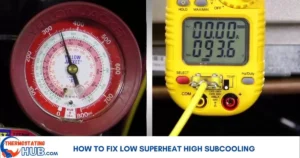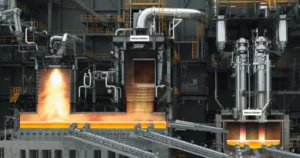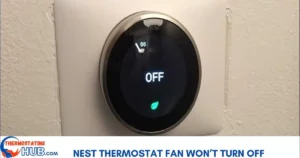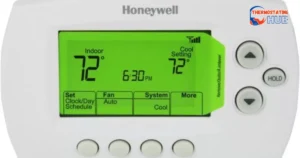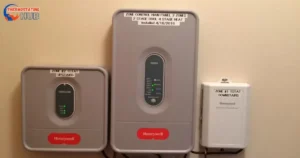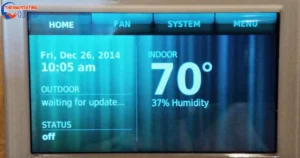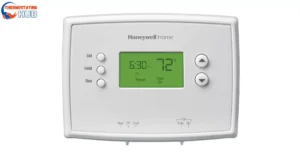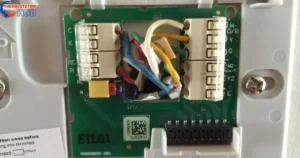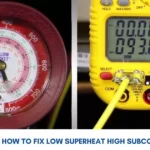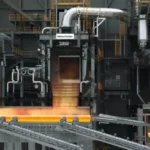Experiencing no condensation or cooling from your air conditioner (A/C) and feeling concerned? Don’t worry; there are a few possible reasons behind this issue, and we’ll delve into them together in this guide, along with their potential solutions.
Typically, the absence of condensation from your AC might stem from several factors: a thermostat set solely to fan mode, low or leaking refrigerant, dirty air filters, or a clogged condensate line. 😓
5 Reasons There is No Condensation from AC
Let’s check out the table summarizing the reasons behind this issue and the potential solutions.
| Possible cause | What to do to fix the problem |
| The thermostat set to fan-only | No action required |
| Low or leaking refrigerant | Seal leaks, and recharge A/C (best handled by a professional) |
| No moisture in the air | No action required |
| Temperature of coils below freezing point | Replace dirty filter |
| Clogged condensate line | Check the condensate line, and clean it if feasible |
Pro tip: Regular HVAC system maintenance, including changing filters and inspecting for leaks, can prevent many common issues.
The thermostat is set to fan
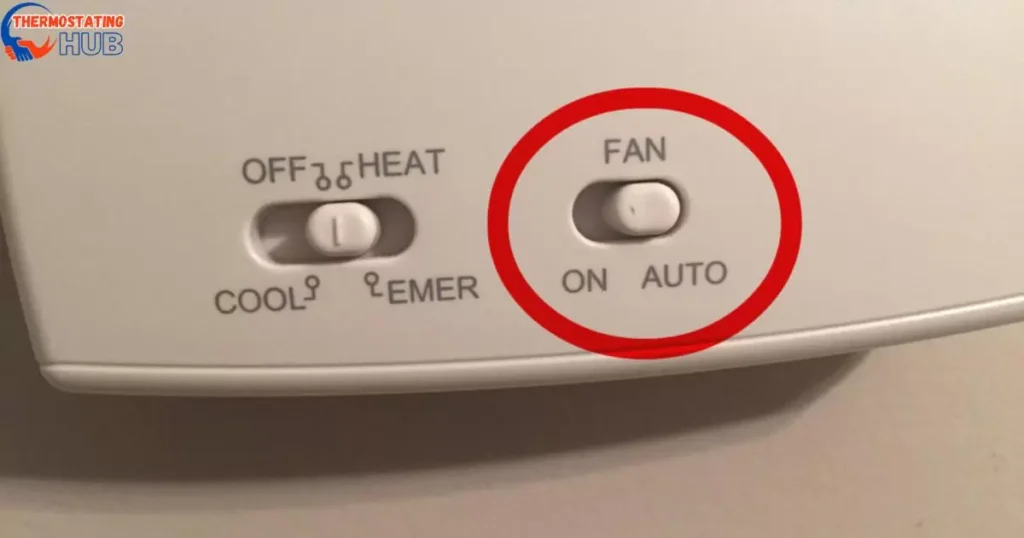
If the thermostat is set to the fan setting, the AC won’t produce condensation as there’s no dehumidification process happening. This happens because condensation in AC systems occurs during compressor operation, involving evaporation and condensation. When the thermostat is on the fan only, the compressor remains off, and only the blower fan circulates air, preventing condensation.
But, if your thermostat is set to cooling and the temperature is lower than the ambient temperature, you should anticipate condensation. If this doesn’t happen, proceed to the next troubleshooting step.
Pro Tip: Regularly check your thermostat settings to ensure optimal functioning and prevent potential issues.
Read also:Dometic Thermostat E1 Code
Low or Leaking refrigerant
The refrigerant in its gaseous form, moves through the evaporator coil, taking in the heat from the air flowing over these coils.
Insufficient cooling of the coils can prevent condensation. This might occur due to a low refrigerant charge, typically caused by leaks in the AC system, resulting in high superheat.
Recharging the AC system with the right amount of refrigerant solves this issue. It’s crucial to entrust this task to a licensed HVAC technician.
Pro tip: Regular maintenance checks for potential leaks in your AC system can help prevent issues like high superheating and ensure efficient cooling. 🛠️
No moisture in the air
One reason why the AC might not produce condensation could be the lack of moisture in the air. An air conditioner cools the air by circulating it over the evaporator coil. When warm air encounters cooler surfaces like the evaporator coil, it releases heat and causes condensation.
Imagine pouring cold water into a glass and circulating air around it. If there’s moisture in the surrounding air, you’ll notice condensation forming on the glass. Similarly, if your AC is functioning properly and providing the expected cooling, lack of condensation might not be a concern.
Pro tip: Ensure proper airflow around the AC unit and regular maintenance to optimize its performance.
Dirty or clogged air filters cause evaporator coils to freeze
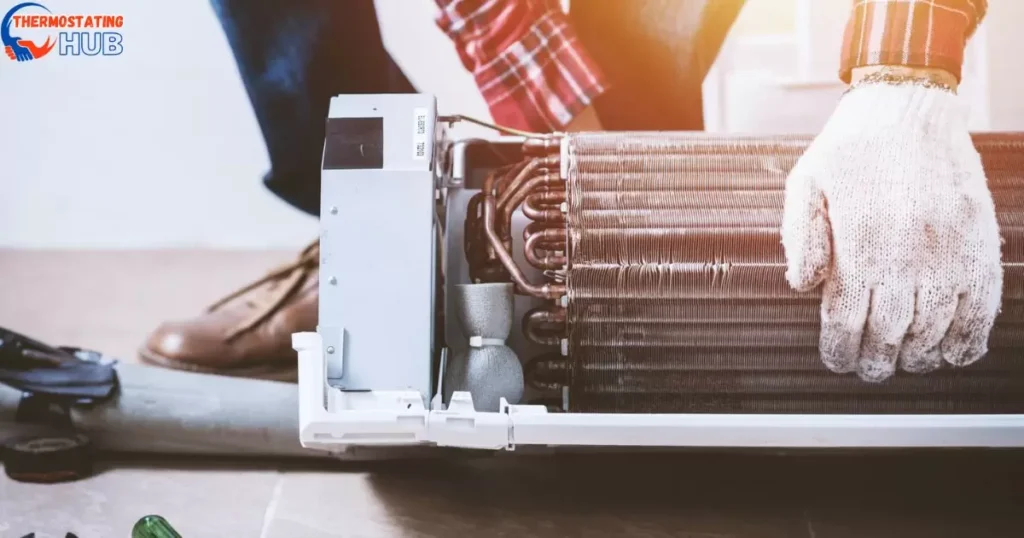
There may be no condensation from the AC because the air lacks moisture. An air conditioner cools the air by moving it over the evaporator coil. When warm air meets cooler surfaces like the evaporator coil, it releases heat and condensation forms.
Think about pouring cold water into a glass and letting air flow around it. If there’s moisture in the air nearby, you’ll notice condensation forming on the glass. Similarly, if your AC is cooling as expected but not producing condensation, it might be due to low moisture in the air.
Pro Tip: Sometimes, in low humidity conditions, ACs might not produce much condensation. Consider using a humidifier in such cases to balance indoor humidity levels for optimal cooling efficiency.
Read also: Mitsubishi Thermostat Symbols Meaning Explained
Blocked condensate line
Condensate lines help drain condensation from the AC. Air reaching the evaporator coils might carry dirt or airborne particles, gradually accumulating and blocking these lines. When this occurs, you might notice a lack of visible condensation from the AC.
Signs of a blocked condensate line include:
- Musty or moldy odor near the indoor unit or from the air vents
- Ineffective cooling of your home by the AC system
- Accumulation of standing water close to the indoor unit
- Water-related damage in surrounding areas
- AC system shutting down or failing to turn on
Pro Tip: Regularly check and clear condensate lines to prevent blockages, ensuring efficient operation of your AC system.
Resolving Condensation and Cooling Issues
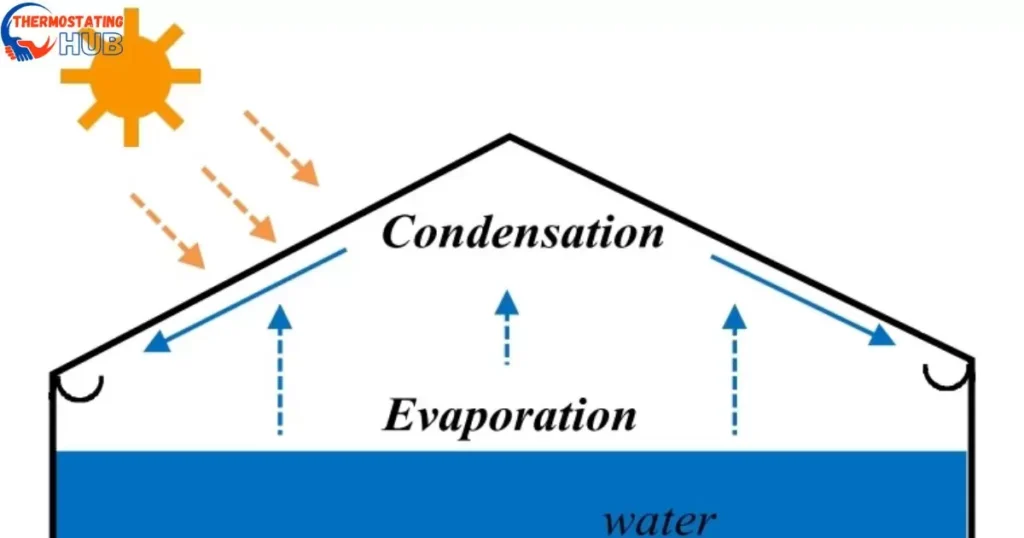
Dealing with AC issues like condensation and cooling problems can be frustrating, but there are ways to troubleshoot these issues. If you notice excess condensation around your AC unit, check for clogged drain lines or a dirty air filter. Clearing out the drain lines and replacing or cleaning the filter can often resolve this problem.
Ensure that the area around the condenser unit is clear of debris and vegetation to allow proper airflow. Sometimes, low refrigerant levels could be the culprit behind cooling problems, so it’s best to have a professional technician inspect and refill the refrigerant if needed.
When your AC isn’t cooling properly, start by adjusting the thermostat to a lower temperature and checking if there’s any cold air coming out of the vents. Verify that all vents are open and unblocked to allow proper air circulation throughout your home. If these steps don’t improve cooling, examine the outdoor unit for any visible damage or obstructions.
Occasionally, a malfunctioning compressor or faulty electrical components could cause cooling issues, which might require professional repair. Regular maintenance and cleaning of your AC system can often prevent these problems, ensuring efficient cooling and reducing the chances of condensation buildup.
Benefits and Drawbacks of Solving Condensation/Cooling Problems
Solving condensation and cooling problems in air conditioning (AC) systems comes with its own set of advantages and disadvantages.
Benefits:
- Improved Air Quality: Addressing condensation issues helps prevent the buildup of moisture, reducing the risk of mold and mildew growth. This enhances indoor air quality, promoting a healthier environment for occupants.
- Enhanced Comfort: Fixing cooling problems ensures consistent and adequate cooling throughout the space, maintaining a comfortable temperature. It prevents discomfort caused by excessively warm or humid indoor conditions.
- Energy Efficiency: By resolving condensation and cooling issues, AC units operate more efficiently. Properly functioning systems consume less energy, leading to lower utility bills and reduced environmental impact.
Drawbacks:
- Costly Repairs: Rectifying condensation or cooling problems in AC systems can sometimes involve significant costs. This includes expenses related to professional inspections, repairs, or even potential replacements of parts or the entire system.
- Time-Consuming: Troubleshooting and fixing these issues can take time, especially if the problem is complex or requires specialized expertise. This could result in inconvenience and discomfort for occupants during the repair process.
- Maintenance Requirements: Even after resolving the immediate problem, AC systems require regular maintenance to prevent future condensation or cooling issues. Neglecting upkeep can lead to recurring problems over time.
Addressing condensation and cooling issues in AC systems is essential for maintaining a comfortable and healthy indoor environment. However, it’s important to weigh the costs and potential disruptions against the benefits to make informed decisions regarding repairs or upgrades.
Read also: Sensi Thermostat Not Turning On AC
Mastering AC Care
To prevent condensation and restore cooling in your AC unit, start with regular maintenance. Clean or replace the air filters every few months to ensure proper airflow and reduce moisture buildup.
Check for any leaks or blockages in the condensate drain line and clear them to prevent water accumulation. Additionally, inspect the insulation around the AC pipes to prevent condensation formation.
For optimal performance, consider scheduling professional maintenance at least once a year. A trained technician can assess your system, clean coils, and check refrigerant levels, ensuring efficient cooling and reducing the risk of condensation issues.
Lastly, maintaining a consistent temperature and humidity level in your home can also help prevent condensation problems in your AC unit, ensuring a comfortable and efficient cooling experience throughout the year.
FAQs
Why is my AC not cooling and no condensation?
The lack of cooling and absence of condensation in your AC unit could indicate issues such as low refrigerant levels, a malfunctioning compressor, a clogged air filter, or a faulty thermostat.
Why is there no condensation coming out of my AC unit?
The absence of condensation might be due to a refrigerant leak, insufficient airflow, or a malfunctioning condensate drain line. These issues could prevent proper moisture removal in the cooling process.
How do I fix my AC running but not cooling?
Several reasons could cause your AC to run but not cool properly. Check for dirty air filters, low refrigerant levels, a malfunctioning compressor, or a faulty thermostat. It’s advisable to consult a professional HVAC technician for an accurate diagnosis and repair.
What is the possible reason for the AC not cooling?
The AC may not be cooling due to various reasons, including low refrigerant levels, a malfunctioning compressor, dirty or blocked condenser coils, a faulty thermostat, or issues with the ductwork. Identifying the exact cause requires a thorough inspection by an HVAC professional.
Final thoughts
We hope you’ve resolved the issue now that you understand why your AC isn’t producing condensation or cooling. If not, it might be a good idea to reach out to a nearby professional for assistance.
Pro Tip: Regularly maintaining your AC unit by cleaning filters and checking for blockages can prevent many cooling problems. 👍

I’m James Wilson, your HVAC maestro from “Thermostating Hub.” Elevate your comfort with my expertise in heating, ventilation, and air conditioning. Let’s transform your space into a haven of perfect temperatures, tackling HVAC issues with precision and enthusiasm.
![No Condensation from AC And No Cooling [Solved]](https://thermostatinghub.com/wp-content/uploads/2023/12/no-condensation-from-ac-and-no-cooling-solved.webp)



